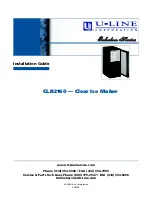
27
‐
NEVER
place the appliance on or next to a stove, oven, … not even if there is a cooker hood.
‐
NEVER
touch the bread maker, the power cord or plug with wet hands and never immerse these parts in water (or
any other liquid). Only clean these parts with a damp cloth. Should the appliance still get wet, immediately
remove the plug.
‐
Children and disabled persons are not always aware of the dangers that could be caused by electrical appliances.
NEVER
let children or disabled persons work with the bread maker.
‐
NEVER
leave the appliance without supervision when it is functioning and
NEVER
move the appliance when it is
functioning.
‐
During the baking process, the viewing window and baking tin get really hot.
ALWAYS
use oven gloves to touch
the viewing window and to remove the bread from the baking tin. Also beware when removing the dough hooks
from the baking tin.
‐
NEVER
use the baking tin for storage of ingredients.
‐
Only switch on the appliance when it is filled with ingredients or dough in order to prevent overheating.
‐
To avoid spilling, remove the baking tin from the appliance to fill it.
‐
NEVER
use accessories or parts from other appliances or other brands.
‐
NEVER
pull the power cord to disconnect the plug.
‐
NEVER
use extension cords and roll out entirely the power cord.
‐
NEVER
turn the power cord around the appliance when it is in use. Never bend or squeeze the power cord.
‐
Never let the power cord hang over the edge of the table or counter.
‐
NEVER
use the appliance if it is damaged. In that case, immediately return the appliance to a registered repair
service.
‐
NEVER
remove the baking tin from the appliance and
NEVER
disconnect the plug while the appliance is in use.
‐
NEVER
touch, block or cover the ventilation holes while the appliance is in use.
‐
ALWAYS
keep the baking tin and dough hook clean, so that the programs can be executed correctly.
‐
The appliance is only meant for Household use.
‐
Only use the appliance for what it is destined, namely making bread and dough.
‐
Persons who have not read this manual cannot use this appliance.
‐
Immediately switch off the appliance and disconnect the plug :
*after use or when the appliance is not in use
*if the appliance is not functioning well
*when cleaning the appliance
2.
Before using the appliance
In the packaging you will find the bread maker, the baking tin, two dough hooks, a measuring cup, a measuring
spoon, a dough hook remover and the user manual with recipes. Before using the appliance for the first time, we
advise you to clean the baking tin, dough hooks , measuring cup and measuring spoon in warm water with detergent,
without using any abrasives, in order not to damage the non-stick coating. Then place the dough hooks inside the
baking tin and fix the baking tin in the appliance. To dismount the appliance, please follow these steps in reverse
order.
V. USE
GENERAL: The final result depends on several factors. Make sure that the ingredients are fresh, at room
temperature and always respect the prescribed quantities.
1. Ingredients
Flour:
Flour is the main ingredient of bread and releases gluten, which allow the bread to rise and which gives
substance to the bread. Always check the packaging to see if the flour is suited for baking bread. The flour weight
varies much from type to type. So it is extremely important to weigh the correct amount on a scale.
Yeast:
Yeast allows the dough to rise and makes the bread light and easy to digest. We advise to use dried yeast
(ready-to-use) as this type keeps much longer and gives a better and more constant result than fresh yeast.
Salt:
Salt enriches the flour and reinforces the gluten in the flour for a better rising process.
Butter/oil:
Butter/oil improves the taste of the bread and makes it softer. This ingredient should be at room
temperature.
















































